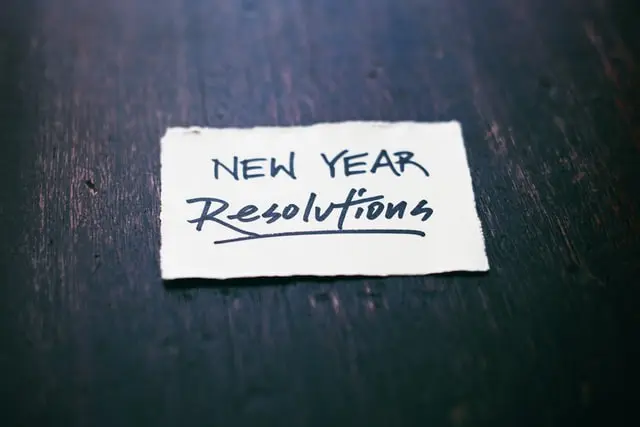Your End of the Year Guide – Finish Strong and Plan for Next Year

The end of the year can be a magical time. It’s a time to reflect on your accomplishments. It’s a time to slow down and catch your breath. Be clever this year, and avoid starting new projects. Take this time to be with your family. Be present and be grateful for all that you have.
I have a ritual that starts on Thanksgiving and ends on the Winter Solstice. I take the end of the year to do deep planning. It’s a habit that profoundly changed my life. It’s also a deeply therapeutic process.
The first step is to check the box on a series of tasks. These tasks do not take a long time and they’re not difficult to complete. The checklist serves several purposes. It organizes your financial world and gets you prepared for next year. It also provides peace of mind so you don’t feel like you missed anything. Finally, it frees your mind from worry so you can focus on deep planning. It’s easier to think deeply when there are no open loops running through your mind.
Financial Checklist
1. Open enrollment, health insurance
Select health insurance option for next year. Consider an HSA if you do not consume a lot of health care. This means infrequent doctor visits, you live a healthy lifestyle, and or don’t regularly take prescription drugs.
2. Review your investments
How did your portfolio perform? Did the stock market go up, down or sideways last year? No matter what, there’s a good chance you can lower our tax bill. There is a little trick called Tax-loss harvesting, that lowers your yearly tax bill. Did you make regular investments to your taxable portfolio during the year? If yes, each buy-order transaction is known as a tax lot. Find any tax lot that lost money during the year.
For example let’s say you bought share of VOO each month. And ten of those buys made money but two of them lost money. Sell the two tax lots that lost money and replace them with another S&P 500 index ETF. So, sell VOO and buy IVV. If possible execute the trades on the same day or on back to back days.
This strategy locks in short term capital losses but you maintain the same exposure to the S&P 500 before and after the trade.
The end of the year is also a great time to rebalance your overall portfolio. Is your asset allocation still on track? Plan your buy and sell order alongside your tax loss harvest trades.
Rebalancing your portfolio is important for long term financial success. It forces you to sell some when the market is up and buy stocks when the market is down. Stick to the plan and don’t let fear or fomo take over.
3. Donate to charity
Giving a little goes a long way. Spending money on others also feels better than spending money on yourself. Hard to believe right? In order these are great things to give away this year. Giving a little is still giving. You can change someone’s day with what you give. Don’t underestimate the value.
- Clothes – Homeless shelters always need clothes and always socks! It’s winter people need socks.
- Food – Thanksgiving day food drives are popular but you can give food all year.
- Toys – Make a kids day and donate toys to a local charity.
- Money – Local organization need funded. Skip the fancy charities and give back to your community.
4. Review your contact and beneficiary information for all financial accounts
This one feels a little like homework. It’s boring but it’s quick. Log into all your account and check the contact information. The banks are doing a better job at remind you these days but it’s a good habit.
Make sure you email, phone, and home address is correct. Find the beneficiary name and update it if needed. Make sure your money stays in the family!
- Bank accounts
- Investment accounts
- Insurance policies
- Credit cards
5. Review your insurance needs
Renting an apartment or a house? Renters insurance is cheap, less than $30 per month, and protects you big time. Get an online quote and policy in a few minute with lemonade. I’ve personally used this service and it’s great. Quick, easy, and painless. I paid $20 bucks a month for renters insurance. It’s great.
Own a house? Protect that big ol’ ass-et, of your. Find a home insurance policy. A few hundred dollars a month can save you hundreds of thousands. It’s a worth it.
You probably have car insurance but it’s a good idea to shop. The insurance companies want your business and they’ll offer you low rates to switch.
Health insurance. Did you forget item #1 on the checklist? Check your coverage and consider switching to a lower cost option if you did not use a lot of health care last year. Many people overpay for health insurance premiums.
6. Get your free annual credit report
You can get a free credit report every year from the big three credit bureaus. They’re required by law to provide one report per year. Go to Annual Credit Report.com and get your reports today. I set a recurring Google Calendar event so I never forget.
Why get a credit report? You’re looking for anything suspicious. You’re looking for credit cards, loans or other debt that you don’t recognize. This happens when someone steals your identify. They pretend to be you and borrow money. You owe that money not them. It’s scary stuff. Check your credit reports.
7. Request a credit limit increase on your credit cards
I’ve been doing this every year for a decade. My monthly available credit is now over 6 figures. It’s crazy. I spend less than 2% of my available credit each month. This helps my credit score and gives me access to a lot of cash in the case of an emergency.
Find all your credit cards. Login to every online account and request a credit limit increase. Go big and ask for a lot. If they don’t approve it, they usually approve a smaller amount. Cards like American Express often approve this in real time.
This 10 minute yearly task improves your credit score. Do it! Also it’s kind of fun.
Reflection
You finished your checklist. Phew. Well done. The reflection process is a journey. It’s not a simple checklist item that you just do one day. Find a few minutes here and there for the next several weeks. Make time for deep thinking. I block out 60 to 90 minutes and really dig in. You do not need to start with that much time. Build up as you find value from the process.
Review progress on current year goals
- What worked
- What didn’t work
Success and failure is a form of feedback. When you’re focused on a goal, the wins and losses tell you if you’re on track. With hindsight, think about all the actions taken throughout the year. Think about all the things you tried to make progress. All the crazy ideas, all the dumb ones, and all the great ones. How did they turn out? Did anything surprise you for better or worse?
Take your learns and roll them forward. You will set better and better goals if you learn from your experiences.
Calculate your net worth
This is a great monthly habit but it’s hard to make a lot of progress in 30 days. It’s been a year, how did you do? A lot can change in a year. Did you invest enough money? How did the stock market do? Watching your net worth grow is exhilarating. Calculate your year over year growth. Next find the trend. Is the graph point up and to the right? Project the trend for the 18 months. Give yourself a sense of where you’re heading over the long run.
Hard look at recurring expenses
Subscriptions are everywhere! All those $9 dollars per month digital services add up. I’m sure you’ve been kicking the can down the field on a few of them. Look yourself in the mirror. Did you actually use this service enough to justify it? Is it really a good value? Will your live be any different without it? Kill all the bullshit services. Don’t put it off any longer. Clip em! Get it done.
Optimize
There are many ways to optimize your personal finances. Here’s the short and sweet version for the end of year.
Automate any repetitive financial task
Identify the tasks you do over and over again. Find the manual things that steal time and focus from your life. Can you automate them? Do you really need to remember to do all this stupid stuff? No, probably not. Almost every financial task can be automated. Technology is great.
Here a few easy ones.
- Bill pay
- Credit cards
- Utilities
- Cable / Internet
- Phone
- Contributions to 401k
- Pay yourself first
- Contribute at least enough to get the full employer match
- Contributions to taxable investment accounts
- Save and invest more money with great apps like Acorns
- Emergency fund savings
- Set up your savings account to automatic take money from your checking account
- Don’t give yourself a chance to spend it, save automatically
Gratitude
Setting goals is best done from a place of gratitude. Take 15 minutes. Sit somewhere quiet and focus on your breathing. Breath slowly and deeply for 3 minutes or until you feel your mind open up. Think about all the beautiful things in your life. Focus on the warmth and joy your favorite people bring into your life. Share your gratitude with the universe. Don’t be shy.
Goal setting
You’re doing great. How productive do you feel? The last step in this guide is goal setting. It’s time to prepare for next year. It’s time to make next year the best year yet!
This can be short and sweet or long and juicy. It’s up to you. When setting goals it’s important to think big. Think so big you inspire yourself. Get the energy flowing! You’ll end up setting a smaller goal. A more attainable goal but don’t limit your thinking in the beginning. That’s a rookie mistake.
Here are the categories I set goals for each year.
- Earn More
- Spend less
- Invest more
- Pay down debt
- Savings rate target
- Net worth target
- Work less on things I hate
- Work more on things I love
Bonus Strategy for the High Achievers – Next year to dos
Investing 100% of your year end bonus is a power habit. It can jump start your journey to financial freedom. If you’re a high earner it can change your life in a hurry. I haven’t spent a bonus check in 8 years.
Here are three things I do with a portion of my bonus check each year.
- Max out IRA
- Max out HSA
- Contribute to 529
I like to invest as early as possible. Get the money in the market and let it work. The day after my bonus check clears the bank, I invest the money. The money I invested when I first start is now worth 100% more than the original bonus. Thank you Mr. Stock Market.
Well there you have it. An overview on my month long end of year journey. Like I said, the end of year can be a wonderful time. Close all your open loops. Take time for yourself and plan the life you want. Spend time with your love ones and be thankful for all you have.

